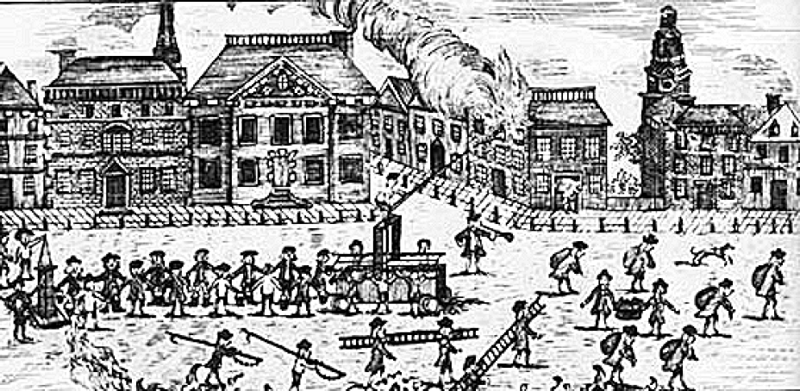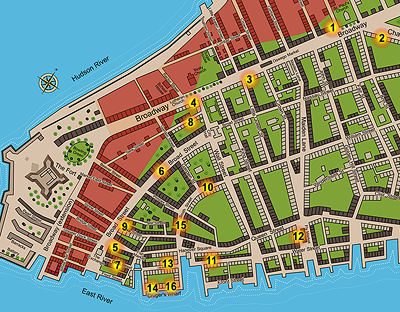Map of Combustibles Found After 1776 Fire

Saving New York: The Colonial FDNY & the American Revolution tells the fascinating story of how the heroic people of New York fought fires, saved lives, and protected their homes and livelihoods during the city's first century. The sweeping narrative follows New York from its Dutch roots and the rapid all-colonist response of the bucket brigade, to the introduction of fire engines and the formation of the first few dozen dedicated volunteers "which Persons shall be Called the Firemen of the City of New York".
By the time of the Revolution, the department had expanded to about one hundred seventy firefighters. Although they were exempt from ordinary military service, none was exempt from the life-altering decisions every New Yorker had to make when the opposing armies descended into the city and the shooting started. What would happen to these firemen in the cauldron of the Revolution?

The war did not give them long to make their decision. Shortly after midnight on September 21, 1776 several fires erupted in lower Manhattan. By daybreak the blazes had consumed five hundred buildings. Decisions made, lines drawn. Some firemen stayed and fought the inferno; others watched their city burn from within Washington's army's lines north of the city. How would the winners of this uncivil war treat those firemen who had made, right or wrong, their impolitic decision?
And who was right or wrong to burn the city, if indeed the cause had a "personal touch." The timing of the fires was suspicious. British troops had been in the city for only a few days after forcing George Washington's army north. As the weight of evidence would eventually show, the fires were not accidental. They were premeditated if not planned, deliberate if not organized, designed to disorient if not devastate.
To access Saving New York: The Colonial FDNY & the American Revolution:
Click the Illustration links for maps and illustrations.
Click the Appendices links for in-depth views of the times.
Introduction: The Colonial FDNY & the American Revolution
Introduces the colonial fire department of New York and its crucial role in saving New York from destruction during raids, rebellions, world wars, and the revolution.
Illustration 1: New-York Fires 1761-1775
Illustration 2: Map of Combustibles Found During/After 1776 Fire
Part One: Origin of the Colonial Fire Department of New York (1640-1740)
The Dutch extend their firefighting system of bucket brigades and the night watch by building an island-wide wall as defense from English attacks and Native American raids. Responding to slave revolts, the city imports fire engines and forms the FDNY.
Chapter 1: Stuyvesant and The Wall
Illustration 3: Guilders, Pelts, and Wampum
Illustration 4: Roelantsen House 1642
Illustration 5: The Palisade Wall & the Plank Wall
Illustration 6: The Distribution of Fire Buckets circa 1660
Illustration 7: The Bucket Brigade
Chapter 2: The Fires of Two Wars, a Revolution, and a Rebellion
Illustration 8: A Map of New York City Wards
Illustration 9: Population of New-York circa 1700 by Ward
Illustration 10: Van der Heyden - New vs. Old Engine Techniques
Chapter 3: Uprisings, Engines, and the Creation of the FDNY
Illustration 11: Slaveholding by Household Class circa 1700
Illustration 12: New-York’s Ethnic Composition for 1700 & 1730
Illustration 13: A Newsham Broadside
Illustration 14: The Newsham Engine circa 1730
Part Two: Developing the 'Modern' Colonial FDNY (1740-1775)
The early FDNY fights arson that threaten to destroy the city. It then expands, funded by war wealth and privateering, into an effective firefighting force. As the Revolution approaches and the shooting begins, firemen are forced to take sides.
Chapter 4: The Fires of 1741 - the FDNY's First Big Test
Illustration 15: Map of the Fires of 1741
Chapter 5: The Watch and the Wars - the FDNY Expands
Illustration 16: Night Watch/Lighting Expenditures
Illustration 17: Map of Wards (Engines & Firemen) circa 1769
Illustration 18: Growth of the FDNY - The First Four Decades
Illustration 19: New-York Fires 1761-1775
Chapter 6: Political Upheaval - the FDNY Under Pressure
Illustration 20: The 1770 List of Merchants Favoring Importation
Illustration 21: Comparison of Firemen in 1772 & 1776
Illustration 22: Firemen in Patriots Military, Loyalists, Others
Part Three: The FDNY and the Revolution (1776-1783)
The Revolution drives most colonists and many firemen from the city. Those who stay fight the largest firestorm in colonial America. A core of Loyalist firemen rebuild the fire department during the war. After the war, will the firemen who fought fires and saved the city be recognized, rewarded, punished, or banished?
Chapter 7: The Great New York Fire of 1776
Illustration 23: The Fire of 1776
Illustration 23a: Map of the New-York Fire of 1776 (Midnight to 2AM)
Illustration 23b: Map of the New-York Fire of 1776 (2AM to 4AM)
Illustration 23c: Map of the New-York Fire of 1776 (4AM to End 11AM)
Illustration 24: Trinity Church Before and After the Fire
Chapter 8: The Carleton Commission
Illustration 25: Map of Combustibles
Illustration 26: Highlights of Carleton Commission
Chapter 9: The FDNY War Years 1777-1783
Illustration 27: The Map of the Fire of 1778
Illustration 28: Fires in New York 1777 – 1783
Illustration 29: Advertisement to Replace Firemen in 1783
Illustration 30: Proposal for a Post-War Fire Department
Part Four: Epilog - The Birth of the New American FDNY (1784)
